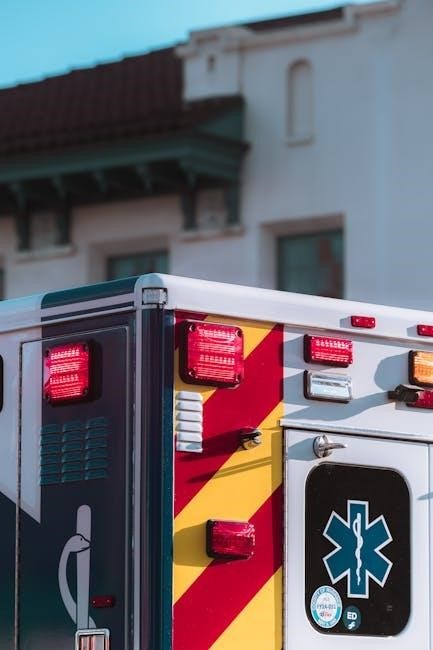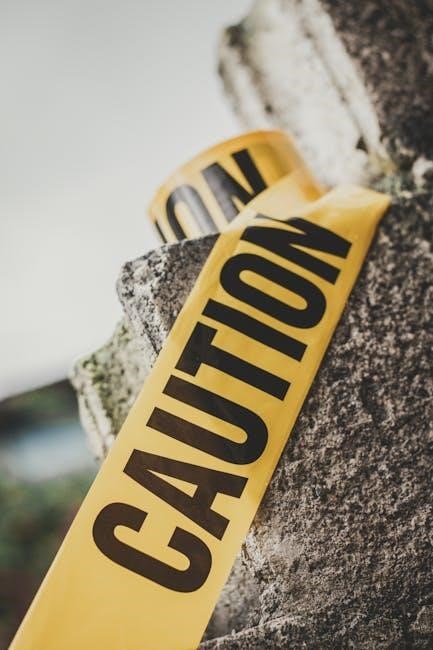First Alert SC9120B Manual: A Comprehensive Guide
The First Alert SC9120B is a crucial device for home safety, designed to protect you and your family from the dangers of smoke and fire․ This comprehensive guide focuses on providing a detailed overview of the First Alert SC9120B smoke alarm, emphasizing its importance in early fire detection․ It is designed to offer peace of mind through its reliable performance․
This guide will walk you through everything you need to know about the SC9120B, from understanding its key features and accessing the user manual to proper installation, testing, and troubleshooting․ We will also cover essential maintenance practices, including battery replacement, ensuring your alarm remains in optimal working condition․ Understanding alarm patterns is vital for quick and appropriate responses․
Additionally, the guide will provide clarity on compliance and safety standards, such as UL217 and ULC S531, reinforcing the necessity of replacing smoke alarms every 10 years․ By following this guide, you can confidently use the SC9120B to enhance your home’s fire safety measures․
Key Features of the SC9120B
The First Alert SC9120B smoke alarm boasts several key features designed to provide reliable and long-lasting protection․ A standout attribute is its sealed 10-year battery, eliminating the need for frequent battery replacements for a decade․ This feature offers convenience and ensures continuous operation, giving you peace of mind that your alarm is always active․
Improved UV resistance is another significant benefit, preventing discoloration over time, which maintains the alarm’s aesthetic appeal and structural integrity․ The SC9120B is designed for easy installation, making it simple to set up and start protecting your home․ It is also built to conform to regulatory requirements, including UL217, ensuring it meets stringent safety standards․
Furthermore, this model features a test button, allowing you to regularly check its functionality․ The alarm is designed to detect smoke effectively, providing early warning in case of a fire․ These features collectively make the First Alert SC9120B a reliable choice for safeguarding your home and family․

Understanding the User Manual
The user manual provides essential information about your First Alert SC9120B smoke alarm․ It covers setup, testing, maintenance, and troubleshooting․ Refer to it for optimal use and safety guidelines to ensure proper functionality of your device․
Accessing the Digital Manual
Accessing the digital manual for your First Alert SC9120B smoke alarm is a straightforward process, offering convenience and accessibility․ First, visit the official First Alert website․ Navigate to the “Support” or “Resource” section, where you can typically find a comprehensive library of product manuals․ Use the search function and enter “SC9120B” to locate the specific manual for your model․
Alternatively, you can perform a web search using keywords such as “First Alert SC9120B manual PDF․” This will often lead you to various websites, including those of retailers or online documentation platforms, where the manual is available for download․
Once you’ve located the digital manual, you’ll usually find it in PDF format․ This format allows for easy viewing, printing, and saving on various devices, including computers, tablets, and smartphones․ Keep the manual readily accessible for future reference, as it contains vital information about alarm testing, maintenance, and troubleshooting․ Having a digital copy ensures you can quickly consult it whenever you have questions or concerns about your smoke alarm’s performance․
Requesting a Physical Copy of the Manual
While digital manuals offer unparalleled convenience, some users may prefer having a physical copy of the First Alert SC9120B manual for easy reference․ Requesting a physical copy is a simple process, though it may require contacting First Alert directly․
First, visit the First Alert website and navigate to their “Contact Us” page․ You’ll typically find options for contacting customer support via phone, email, or online chat․ Explain that you’re seeking a physical copy of the SC9120B manual and provide your mailing address․
Alternatively, you can call First Alert’s customer service line directly․ Be prepared to provide the model number (SC9120B) and any other relevant information to help them locate the correct manual․ In some cases, retailers that sell the SC9120B may also be able to provide a physical copy of the manual, especially if you purchased the alarm from them․
Keep in mind that there might be a small fee associated with requesting a printed manual, or it may be complimentary․ Once your request is processed, the manual will be mailed to your provided address․

Installation and Setup
Proper installation is crucial for the SC9120B’s effectiveness․ This section outlines the necessary steps for installing and setting up your smoke alarm, ensuring it functions correctly to protect your home and family from potential fire hazards․

Step-by-Step Installation Guide
Installing your First Alert SC9120B smoke alarm correctly is paramount for optimal performance․ Begin by selecting a suitable location, avoiding areas near kitchens or bathrooms where steam or cooking fumes might trigger false alarms; Ideally, place the alarm on the ceiling or high on a wall, ensuring it’s at least four inches from any corner․
Once you’ve chosen the location, use the mounting bracket as a template to mark the screw holes․ Drill the holes and insert the anchors if necessary․ Secure the mounting bracket to the ceiling or wall․ Next, connect the battery to the SC9120B, following the polarity markings․ Attach the alarm to the mounting bracket by twisting it into place until it clicks securely․

Finally, test the alarm by pressing the test button․ A loud, clear alarm should sound․ If the alarm doesn’t sound, double-check the battery connection and ensure the alarm is properly attached to the bracket․ Repeat the test regularly to confirm functionality․
Initial Setup Procedures
Upon installing your First Alert SC9120B smoke alarm, initiating the setup correctly is crucial for seamless operation․ First, ensure the battery is properly connected․ The SC9120B utilizes a sealed, 10-year battery, eliminating the need for frequent replacements․ After connecting the battery, the alarm will automatically power on․
Next, familiarize yourself with the test button, typically located on the alarm’s front․ Press and hold this button for a few seconds․ The alarm should emit a loud, piercing sound, confirming its functionality․ If no sound is heard, recheck the battery connection․ It’s also advisable to consult the user manual for specific troubleshooting steps․
Finally, after successful testing, record the installation date on the alarm itself․ This will help you track when the alarm needs replacement, as recommended every 10 years․ Regular testing and adherence to the recommended replacement schedule ensure continuous protection․

Testing and Maintenance
Regular testing of your First Alert SC9120B is crucial․ Understanding alarm patterns helps identify potential issues․ Battery replacements should follow specified procedures for continuous protection and peace of mind in your home․
Performing Regular Functionality Tests
To ensure your First Alert SC9120B smoke alarm is functioning correctly, regular testing is paramount․ The manufacturer recommends performing a functionality test at least once a week․ This simple procedure can provide invaluable assurance that your alarm will perform as intended in the event of a fire․
Locate the test button on the alarm’s front․ Press and hold this button for several seconds․ The alarm should emit a loud, piercing sound if it’s working properly․ If the alarm fails to sound, it may indicate a problem with the power supply or the unit itself․
Before conducting the test, notify family members to avoid causing unnecessary alarm or panic․ This is especially important if you have young children or individuals with sensitivities to loud noises․
If the alarm doesn’t sound during the test, first check the battery․ If the battery is low or depleted, replace it with a new one․ After replacing the battery, repeat the test․ If the alarm still doesn’t sound, the unit may be defective and require replacement;
Consistent testing is a cornerstone of fire safety․ It helps detect issues early, ensuring your SC9120B provides reliable protection․
Understanding Alarm Patterns
The First Alert SC9120B smoke alarm uses distinct alarm patterns to communicate different events․ Recognizing these patterns is crucial for responding appropriately in an emergency․ The primary alarm pattern indicates the presence of smoke and a potential fire․ This is typically a loud, continuous, and pulsating sound, designed to awaken occupants and alert them to danger․
It’s important to differentiate this fire alarm from other sounds the detector might make․ For instance, a chirping sound, often referred to as a “low battery” chirp, indicates that the battery needs replacement․ This chirp usually occurs every minute or so and should not be confused with the continuous alarm of a fire․
Some models might feature a “hush” or “silence” button․ When activated during a nuisance alarm (e․g․, from cooking smoke), the alarm will temporarily silence itself․ Understanding how to use this feature is vital to avoid unnecessary panic and disruption․
Familiarizing yourself and your family with these distinct alarm patterns will ensure quick and effective responses in the event of an emergency, potentially saving lives and minimizing damage․
Battery Replacement Procedures
Maintaining a functional First Alert SC9120B smoke alarm requires timely battery replacements․ When the alarm begins to chirp intermittently, typically about once a minute, it indicates a low battery․ Promptly replacing the battery is crucial for ensuring continuous protection․

To replace the battery, first, gently twist the alarm to detach it from the mounting bracket․ Open the battery compartment, usually located on the back or side of the unit․ Remove the old battery and dispose of it properly, following local regulations for battery disposal․
Insert a new 9-volt battery, ensuring it is correctly oriented according to the polarity markings inside the compartment․ Close the battery compartment securely․ Reattach the alarm to the mounting bracket by twisting it until it locks into place․
After replacing the battery, test the alarm by pressing the test button․ The alarm should sound a loud, clear siren․ If the alarm does not sound, double-check the battery installation and try again․ If it still fails to sound, consider replacing the entire unit, especially if it is nearing its 10-year lifespan․

Troubleshooting
Experiencing issues with your First Alert SC9120B? This section addresses common problems like false alarms, chirping, and failure to test․ Find solutions to ensure your smoke alarm functions correctly and keeps you safe․
Common Issues and Solutions
Encountering problems with your First Alert SC9120B smoke alarm can be frustrating, but most issues have straightforward solutions․ One common issue is nuisance alarms, often triggered by steam from showers or cooking fumes․ Relocating the alarm further away from these sources can help prevent these false alarms․
Another frequent problem is the alarm chirping intermittently․ This usually indicates a low battery․ Replacing the battery with a fresh one typically resolves this issue․ Ensure you use the correct type of battery as specified in the user manual․
If the alarm fails to sound during the test, first verify that the battery is correctly installed and has sufficient charge․ If the problem persists after replacing the battery, the alarm itself may be faulty and require replacement․ Remember that smoke alarms have a limited lifespan and should be replaced every ten years, as recommended by safety standards․
Consult your user manual for more detailed troubleshooting steps and safety information․

Compliance and Safety Information
First Alert smoke alarms, including the SC9120B, comply with regulatory requirements like UL217 and ULC S531․ Smoke alarms need replacing every 10 years․ Always consult the user manual․
Regulatory Compliance (UL217, ULC S531)
The First Alert SC9120B smoke alarm is designed and manufactured to meet stringent regulatory compliance standards, ensuring reliable performance and adherence to safety guidelines․ Notably, this smoke alarm conforms to UL217, the standard for safety for single and multiple station smoke alarms, outlining rigorous testing procedures and performance criteria․ Furthermore, the SC9120B also complies with ULC S531, the Canadian standard for smoke alarms, reflecting its commitment to meeting safety standards across North America․

These certifications signify that the SC9120B has undergone extensive evaluation to verify its ability to detect smoke effectively and provide timely alerts, offering enhanced protection against fire hazards․ Meeting these standards ensures the alarm’s reliability and contributes to overall home safety․ By adhering to UL217 and ULC S531, First Alert demonstrates a dedication to providing consumers with dependable and trustworthy smoke detection devices․
Importance of Smoke Alarm Replacement Every 10 Years
Replacing smoke alarms every 10 years is a crucial safety measure recommended by the National Fire Protection Association (NFPA)․ Over time, smoke sensors can degrade due to dust accumulation, humidity, and other environmental factors, diminishing their ability to detect smoke effectively․ This reduced sensitivity can compromise the alarm’s ability to provide timely warnings during a fire, potentially endangering lives․
The First Alert SC9120B, like all smoke alarms, has a limited lifespan․ After a decade, internal components may become less reliable, increasing the risk of malfunction or failure․ Regularly replacing smoke alarms ensures they operate at peak performance, providing the best possible protection against fire hazards․ By adhering to the 10-year replacement guideline, homeowners can maintain a reliable fire safety system and safeguard their families․